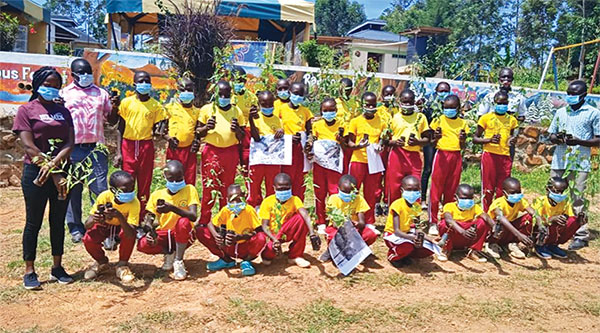Local resident Jim Cummings, a lifelong educator, has a longstanding passion for combating climate change and involving younger generations, both here in the United States and in Kenya. When Cummings discovered the Kenyan government’s plan to plant two billion seedlings by 2022 and the United Nations sounded “code red for humanity” on climate change in August 2021, he began to generate ideas for how his nonprofit organization, the Kijana Educational Empowerment Initiative, could be a part of the solution. Cummings then spearheaded and achieved a massive initiative to plant 500,000 trees.
Kijana operates in the U.S. and in Kenya, promoting and cultivating youth empowerment through educational development, cross-cultural dialogue, and sustainable and environmentally friendly economic growth. Thanks to the financial support from philanthropists, schools, businesses and churches in the U.S, Kijana has served a pivotal role in transforming education and lives in Kenya by investing in more than 30 schools since 1998.
One such funding effort catapulted Cummings’ tree-planting endeavor. Kijana received support in March 2021 to develop an environmentally centered program at the Kijana Global Innovation School, an independent school that Kijana is in the process of building. The unique, experiential environmental education program aims to protect and value life on earth — human, non-human and plant.
“At its core is the idea of getting students out exploring into the local and regional environment. The grant also included funding to plant trees, develop a pollinator garden, get environmental books, a few computers and other resources for exploratory trips,” Cummings said.
As the founder and president of Kijana, Cummings spends his time straddled between two continents, mostly raising money and developing relationships in the U.S. and then overseeing the execution of Kijana’s programs on the ground in Kenya. On a recent trip to Kenya last summer, Cummings and some of his team members engaged in collaborative discussions related to tree-planting and how to best implement the $6,000 budget to acquire 6,000 seedlings and distribute the trees.
“I discovered that the Kenyan government had a plan to plant two billion trees. So, I wondered how far they had gone,” Cummings said.
He wondered how Kenya could meet its goal, which had a target of increasing the country’s forest cover from 7 percent to 10 percent. He researched the number of sublocations in Kenya and found that when the 6,612 sublocations were divided into two billion, each sublocation would need to plant 302,480 trees.
Thanks to Kijana’s recent hire of Mercy Chepsuge, a young environmentalist, new ideas emerged for the Kijana team to exceed its original goal of planting 6,000 trees and achieve the goal of planting 302,480 trees in the Buchenya sublocation.
Chepsuge explained that a small sachet of seeds, one kilo, could produce around 30,000 seedlings and cost about $50. “If we planted our own seedbed, we could generate 30,000 or so seedlings,” Cumming said. “Then to get 300,000, we would need nine other entities in the sublocation to do the same.”
Their goal quickly shifted course: build a community alliance with the six churches and three other schools in the area, and each would plant one seedbed and generate 30,000 trees. Kijana would pay for the seeds, the netting and the sleeves for holding the seedlings once they emerged from the ground; the church or school would fund the soil/sand and wood or brick frame for the seedbed and water the seedlings. One church and two primary schools agreed to participate.
Chepsuge led the tree planting efforts. All 130 students from Kijana School participated in learning every aspect of tree planting in order to develop different skills, including reliability, responsibility, curiosity, exploratory nature, teamwork, creativity and growing the love for nature.
Concurrently, Cummings deployed teams in Kisumu, Luanda, Nairobi and Tassia to do the same. Once again, a new tree planting goal sprouted.
“We embarked upon an ambitious plan to grow 500,000 trees by Dec. 15, 2021, to show that it is possible to contribute significantly to global reforestation and canopy building through community teamwork,” he said.
The Kijana team members reached out to more than 30 schools, churches and other non-governmental organizations throughout Kenya. Through much work and persistence, they succeeded in growing more than 500,000 seedlings from seed in five months.
Cummings hopes “this will be a model and inspiration for other communities globally to take immediate and collective action to mitigate climate change and build better communities, as well as set an example for young and old to work together to green our planet.”
He noted that climate change will not be solved from a top-down government approach alone. Cummings encourages all citizens to take initiative, and “with a concerted, organized effort by small institutions on the ground, we can make something significant happen.”








